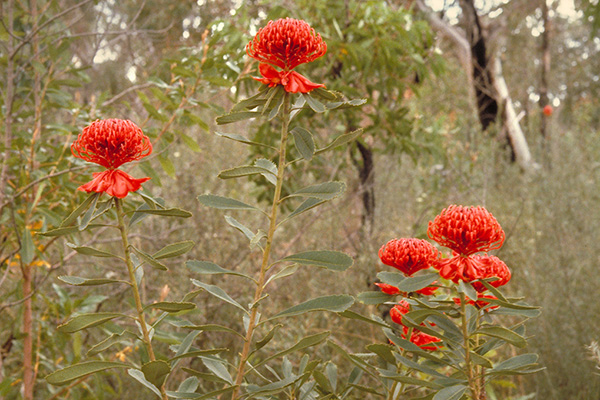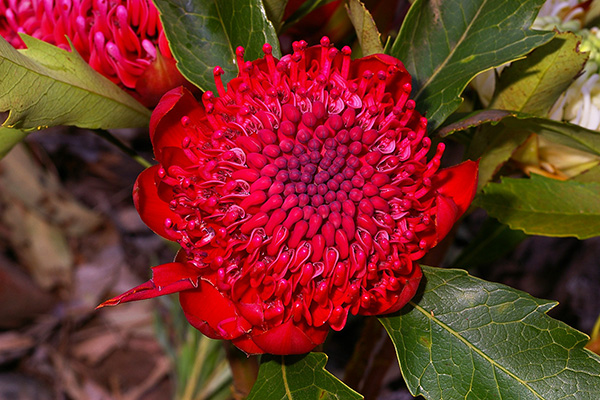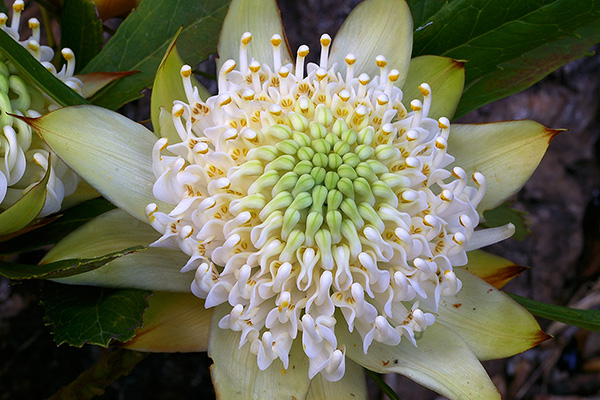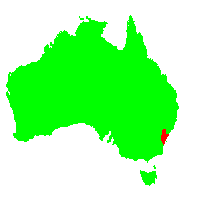General Description:
The genus Telopea contains five species all confined to east coast regions from northern New South Wales to Tasmania. Telopea speciosissima is the floral emblem of New South Wales and one of Australia’s most beautiful and spectacular native plants. It was one of the first Australian plants to be collected for cultivation in Europe as it was common in the sandstone country around the first European settlement at Port Jackson.
Telopea speciosissima is an upright shrub to about 3 metres but is often shorter. It usually grows as a single or few-stemmed plant until it is cut back by fire. The plant then regenerates from an underground lignotuber and may become multi-stemmed. The leaves are large, leathery and may be irregularly serrated. They are up to 250 mm long. The flowers occur in a tight cluster at the ends of the erect stems and, overall, the inflorescence can be 150 mm or more in diameter and is usually a brilliant red. Large, leafy bracts occur at the base of the inflorescence. Flowering occurs from mid spring to early summer.
In the wild, T.speciosissima it is restricted to an area within about 200 km of Sydney. For many years the species was also regarded as occurring in the Gibraltar Range in northern New South Wales but this has now been classified as a distinct species (T.aspera). Superficially the two species are similar in both flower and growth habit.
The waratah is almost the ideal cut flower, being long lasting with flowers occurring terminally on long straight stems. The species is widely cultivated for the cut flower market both in Australia and overseas. Despite this the plant has not proven to be easy to cultivate under normal garden conditions. Some of the best plants in cultivation have been observed growing in deep sand or sandy loam with excellent drainage but assured moisture. However, they are adaptable to other soils types. For example, they grow extremely well in the basaltic soils in the Dandenong Ranges east of Melbourne (see footnote).
A sunny or lightly shaded position is preferred and plants will not thrive in heavily shaded areas or within the canopy of large established trees. Fertilising with a slow release, low-phosphorus fertiliser after flowering is beneficial. Plants are tolerant of at least moderate frost.
A number of selected forms of T.speciosissima are being brought into cultivation as well as hybrids with other Telopea species. Cultivars exhibit variations in the colour of the flowers and/or the bracts and include:
- ‘Fire ‘n’ Ice’ (red with white tips)
- ‘Songlines’ (pink in bud, opening flame red)
- ‘Dreaming’ (styles open white and mature to pink)
- ‘Shade of Pale’ (cream tinged with pink)
- ‘Brimstone Blush’ (red with a pink blush)
- ‘Wirrimbirra White’ – probably the most famous colour variant, being almost pure white.
Propagation of T.speciosissima is best from seed which should germinate within 4-6 weeks if it is viable. No special pretreatment is necessary but seedlings are susceptible to damping off (a fungal disease) and need to be kept under observation. T.speciosissima can also be grown from cuttings by experienced growers. Propagation of selected, named cultivars and hybrids MUST be carried out from cuttings (or other asexual methods) as seedlings from these cultivars will not produce plants true to type.
Note on soil types (thanks to Gary Clark, La Trobe University):
As noted above, T.speciosissima (and its cultivars) grows well on the basaltic soils of the Dandenong ranges. While this is true, it may be misleading for potential growers not aware of the soil types in the Dandenongs. For instance, compared to the heavy basaltic soils west of Melbourne, the soils in the Dandenong ranges are quite different. The best horticultural soils are based on highly weathered Devonian basalts. These soils are Ferrosols or Krasnozems (in older terminology). These soils have excellent drainage, tend to be acidic and low in fertility, especially phosphorus, and quite deep. This is probably why waratahs and proteas do well.

Telopea speciosissima in habitat on the central coast of New South Wales
Photo: Brian Walters

Telopea speciosissima – the normal red form
Photo: Brian Walters

Telopea speciosissima ‘Wirrimbirra White’
Photo: Brian Walters
Other Native Plant Profiles
 Australian Native Plants Society (Australia)
Australian Native Plants Society (Australia)













